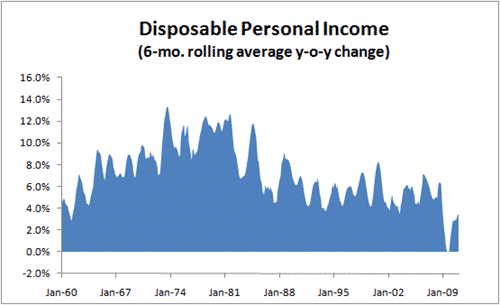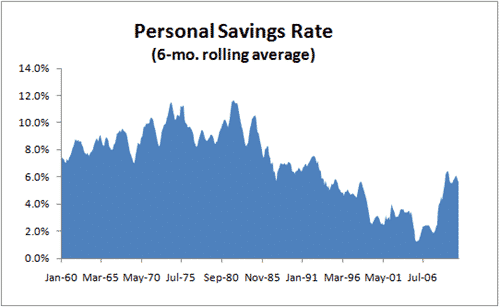January personal income data best macro news in a while
Today’s release on U.S. Personal Income and Outlays from January 2011 was a nice change of pace from the worries that food and commodity price inflation have caused over the past month. We saw personal income up an annualized $133 billion or 1.0% month-on-month. That’s a robust reading that allows consumer spending to tick up a bit as well.
The numbers we should concentrate on however are the personal savings rate and real disposable personal income (real DPI) i.e. what workers have in their pockets after taxes and inflation. U.S. households are highly indebted and so we want to see both of these numbers ticking up because it means economic growth underpinned by savings instead of debt accumulation. While the real DPI number was only 0.4%, that’s still a relatively good number because the savings rate came in at 5.8%, up from 5.4% in December. (Note, however, that the income numbers were boosted artificially by treatment for the expiration of the Making Work Pay provisions of the 2009 stimulus bill.)
On the whole, this looks to be a good report. More data analysis coming shortly.
Update: Here are the relevant numbers I tend to look at.
- Average Real DPI growth: I take the 6-month rolling average of real disposable personal income and track its change year-on-year. This helps to smooth out anomalies like the tax distortion from this past month. Average Real DPI bottomed at –0.1% in October 2009 and is presently at 3.5%, its highest level since December 2008.
- Average Savings Rate: I take the rolling average of savings over the last six months to smooth out month-to-month trends and see how the data tracks over time. As I noted early this month, the average personal savings rate peaked in the summer of 2009 at 6.4%. (See Back to the global imbalances norm). It is not a coincidence that this peak occurred exactly when average disposable personal income was low. The psychology of recession is to increase precautionary savings due to an economic downdraft. As the economy has recovered, savings levels have fallen somewhat. The average over the last six months is now 5.7%.
Bottom Line: My analysis of the data sees the rise in average disposable personal income as a trend that is favourable. The fall in savings rates is small but somewhat worrying given the large debt overhang in the household sector. With 2010 Q4 being revised down, with initial jobless claims still hovering around 400,000 and with the recent rise in food and energy prices, I would say this is the best macro data we have had for quite some time.


Comments are closed.